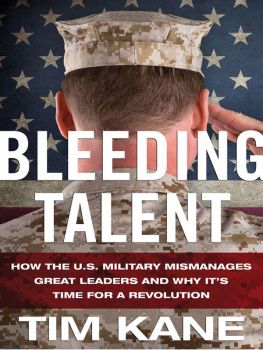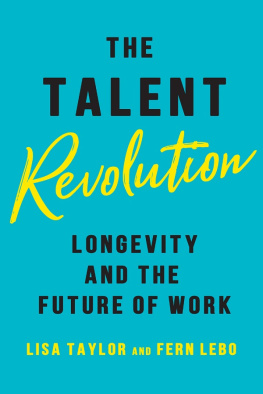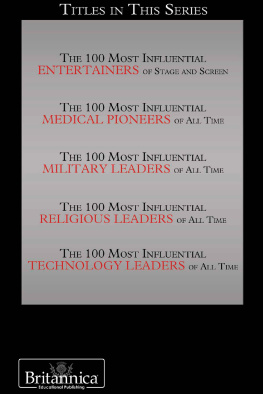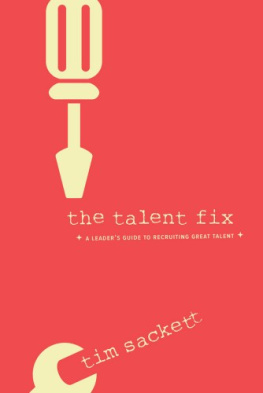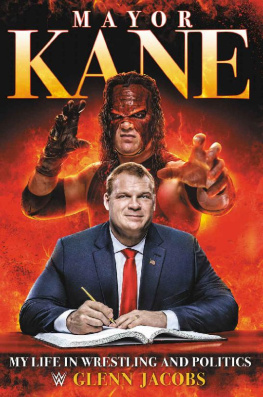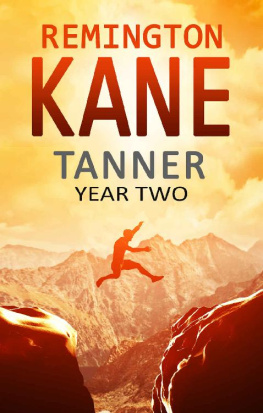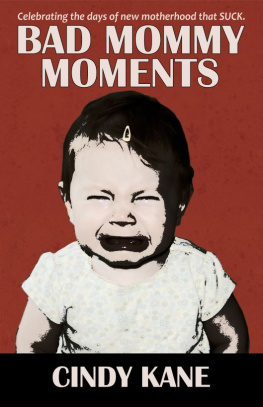BLEEDING TALENT
BLEEDING TALENT
HOW THE US MILITARY MISMANAGES
GREAT LEADERS AND WHY ITS
TIME FOR A REVOLUTION
TIM KANE


BLEEDING TALENT
Copyright Tim Kane, 2012.
All rights reserved.
First published in 2012 by
PALGRAVE MACMILLAN
in the United Statesa division of St. Martins Press LLC,
175 Fifth Avenue, New York, NY 10010.
Where this book is distributed in the UK, Europe and the rest of the world, this is by Palgrave Macmillan, a division of Macmillan Publishers Limited, registered in England, company number 785998, of Houndmills, Basingstoke, Hampshire RG21 6XS.
Palgrave Macmillan is the global academic imprint of the above companies and has companies and representatives throughout the world.
Palgrave and Macmillan are registered trademarks in the United States, the United Kingdom, Europe and other countries.
ISBN: 9780230391277
Library of Congress Cataloging-in-Publication Data
Kane, Tim.
Bleeding talent : how the US military mismanages great leaders and why its time for a revolution / Tim Kane. p. cm. ISBN 9780230391277 1. Command of troops. 2. LeadershipUnited States. I. Title.
UB210.K363 2012
355.680973dc23 2012021609
A catalogue record of the book is available from the British Library.
Design by Newgen Imaging Systems, (P) Ltd., Chennai, India.
First edition: December 2012
10 ;9 ;8 ;7 ;6 ;5 ;4 ;3 ;2 ;1
Printed in the United States of America.
To my brothers and sisters from the United States
Air Force Academy, class of Mighty 90
CONTENTS
FIGURES AND TABLES
FIGURES
TABLES
ACKNOWLEDGMENTS
I AM GRATEFUL TO THE MEN AND WOMEN who serve in the US military for sharing their experiences with me, including veterans and active duty service members of all ranks. During a time of war, the sacrifices of our nations volunteers are humbling, and I hope that my words here are able to fairly represent their diverse views. I would especially like to thank those 250 West Point graduates who responded to the two surveys I conducted in late 2010. I am also thankful to another group of Naval Academy graduates who participated in a similar survey with similar results, but my inability to garner a sufficient sample size precluded publishing the figures here.
In particular, Id like to thank the many individuals who helped me design the survey questions and think more carefully about the issues at stake. Those include James Carafano, Mike Carter, William Casebeer, Scott Clemenson, Kyle Davis, Joe Deane, Anthony DeToto, Dean Dorman, Jason Dempsey, Nathan Estruth, Guy Filippelli, Alyse Freilich, Scott Halter, Grover Harms, Warren Hearnes, Steve Kiser, Beau Laskey, Robert Litan, Mike Meese, John Nagl, Shawn Olds, Kelly Perdew, Jeff Peterson, Jeff Philippart, Dan Rice, Robert Strom, Troy Thomas, Don Vandergriff, Josh Weed, Russ Laraway, and Elad Yoran. Many of these individuals provided invaluable feedback on early drafts of the manuscript.
I am indebted to the active duty officers in the US Army who advised me while I wrote this book, and who shall remain nameless in order to protect their careers. Many wrote me emails from the battlefield as well as from the Pentagon asking to be anonymous. Some talked to me for hours over the phone and waited for weeks for my slow responses. Thank you for your confidence in me and your patience.
The Ewing Marion Kauffman Foundation was my employer while this book was conceived and written, and I owe a particular debt of gratitude to Bob Litan and Carl Schramm for their support. The Hudson Institute, my current employer, has graciously supported me while I finalized the manuscript and prepared it for publication.
Laurie Harting at Palgrave Macmillan has been a godsend as an editorpatient, smart, and unbelievably supportive. Thank you to all of the folks at Palgrave who guided me through this process, especially Leigh Westerfield for her copyedits. Evelyn Smith and Naoko Funatsu provided excellent support at the Hudson Institute during the final stages of editing. My friend Mindee Forman was just amazing as an editor who made the manuscript so much stronger than the rough text I sent her way for an amazingly fast rewrite. Also, I cannot express enough thanks to Jill Marsal at the Marsal Lyon Literary Agency for taking a risk on me and this project. Thanks as well to the editors at The Atlantic for publishing the initial essay that made such a splash. My friend Ben Wildavsky deserves no small amount of credit for making the draft essay twice as good after his magic touch.
My final debt is to my wife, Hiromi, and our four wonderful children, Sean, Naomi, Katherine, and Lauren. Thanks for your love and support.
INTRODUCTION
SUMMER, 1998. JIM COYER AND I ARE SIPPING beers on the patio, overlooking the canyon behind my new house in San Diego. Jim and I had founded NeocorTech four years before, a software company that was more of a hobby than a business, and yet there we were enjoying the benefits of a $1 million dollar cash sale. Jim got a third. I got a third. Our other partners and employees got a third. And, we literally forgot Uncle Sam, who also wanted a third in income taxes. That left my wife and me with just enough of a payoff to justify four years without a salary or health insurance, and it meant that we could buy three things put off for way too long. A new house with a yard, where I could build a sandbox for our two kids. A puppy. And, finally, some new socks and underwear.
That year, we rocketed from the lowest tax bracket to the top (and back the very next year), but I cant begrudge Uncle Sam his cut. It was thanks to the US government that I met Jim when we were cadets at the Air Force Academy. That was a special place for me, a place where I met young men and women who were destined to be more than friends. Brothers and sisters.
Cadet Coyer was a doolie (freshman) in my squadron, and although I basically hazed him for the first year of our acquaintance, I also knew he was one of the smartest, most insightful, and most competitive people I would ever meet. Like most cadets, Coyer and I dreamed of flying space shuttles, leading the nation in battle, pushing the frontiers of science, making the world safe for democracy... little stuff like that. We were cold warriors then, children of Ronald Reagan, getting ready to face off against the Soviets and, in the meantime, sneaking beers and girls into the dorm. Even now, we laugh about boxing classes, obstacle courses, marches to the morning meal, spit-shined combat boots, tours for demerits, spirit cheese, and our ready response for any challengeone of the seven sentences doolies are permitted to sayNo excuse, sir!
Fast forward a decade, a company, and many beers, and I couldnt help dreaming new dreams. You know whats next, dont you? I said, as Jim and I clinked our Heinekens.
Another company on your mind already? Jim asked. He had that big grin on his face, ready to take on the world. And I saw something there that I dont see in many other faces. Trust. This was a guy I would die for, and who would die for me. How can you put a value on trust in business?
You know it. Internet privacy, its gonna be big. Jim did the coding. I did the marketing, sales, accounting, legal, taxes, and negotiations. We both did the dreaming, and cofounded enonymous.com a few days later.
Although San Diego isnt nearly the tech mecca that Silicon Valley is, Jim and I had created some buzz in the local venture community. A million dollars isnt huge news, but we had flown under the radar. No investors in our first company. All sweat equity. And it was 1998 after all, so venture money was hungry for new deals, proven entrepreneurs. Within a couple of weeks, Jim was hacking the code, and I was ready to shop the PowerPoint presentation around town.
Next page
